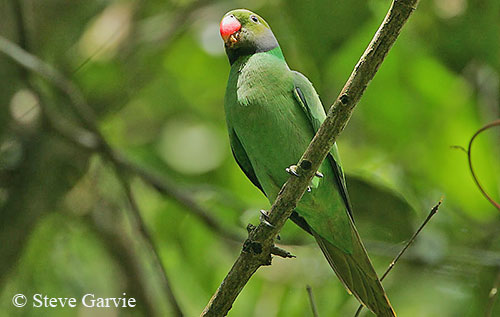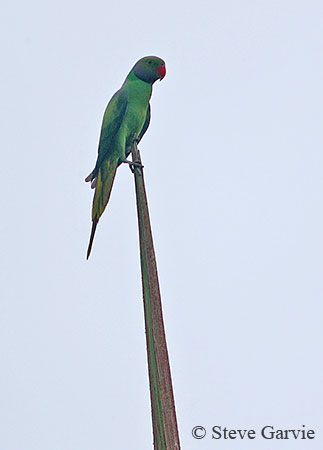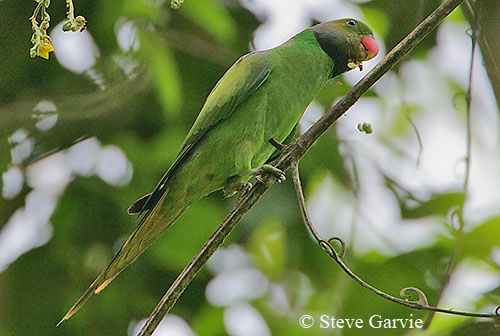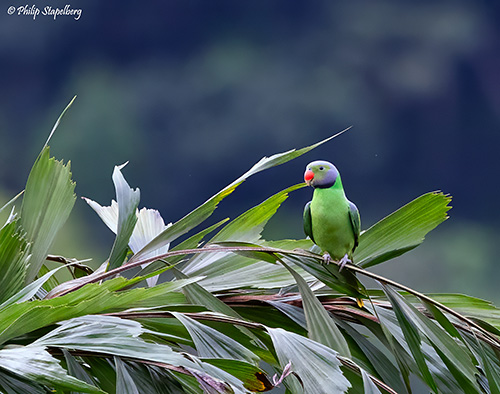
Fr: Perruche de Layard
Ang: Layard's Parakeet - Emerald-collared Parakeet
All: Blauschwanzsittich
Esp: Cotorra de Ceilán
Ita: Parrocchetto di Layard
Nd: Smaragdparkiet
Sd: smaragdparakit
Photographers:
Steve Garvie
RAINBIRDER Photo galleries
Philip Stapelberg
GALLERY
Alan & Ann Tate
AA Bird Photography
Text by Nicole Bouglouan
Sources:
HANDBOOK OF THE BIRDS OF THE WORLD vol 4 by Josep del Hoyo-Andrew Elliott-Jordi Sargatal - Lynx Edicions - ISBN: 8487334229
PARROTS OF THE WORLD – An Identification Guide – by Joseph M. Forshaw – Princeton University Press – ISBN 0691092516
Sri Lanka Emerald-collared Parakeet
Endemic Birds of Sri Lanka - Alu Girawa - Layard's Parakeet (Psittacula calthropae)
Wikipedia, the free encyclopaedia
Layard's Parakeet or Emerald-collared Parakeet
Psittacula calthrapae
Psittaciformes Order – Psittaculidae Family
INTRODUCTION:
The Layard's Parakeet or Emerald-collared Parakeet is a resident endemic breeder in Sri Lanka.
The name of the bird pays tribute to the British naturalist Edgar Leopold Layard.
The species is mainly a forest bird often seen in clearings and at the edges. It may perform some local movements, depending on the availability of fruits, seeds and buds included in its diet. It feeds quietly in treetops.
The Layard's Parakeet nests in natural cavities, usually holes in trees.
The Layard's Parakeet is described as locally common, but the numbers are declining due to heavy deforestation in the restricted range. However, the species is not globally threatened at the moment.
DESCRIPTION OF THE BIRD:
Biometrics:
Length: 29-30 cm
Weight: 100 g
The Layard's Parakeet adult male has bluish-grey upperparts, strongly washed grey-mauve. On the dull green upperwing, the median wing-coverts are yellowish-green, forming a patch on the folded wings. The lesser wing-coverts are greyish.
The medium-sized tail is deep blue with pale yellow tip.
The underparts are emerald-green with slightly washed yellowish-green undertail-coverts. The undertail is yellow.

On the dark bluish-grey head, the face is bright green. Chin and neck sides are black. A broad, emerald-green collar extends around the neck and onto the underparts.
The bill is coral-red with yellow tip on upper mandible, whereas the lower mandible is brownish.
The eyes are pale yellow.
Legs and feet are greenish-grey.
The adult female resembles male, but she has little green on the face, especially on lores, and the head appears almost entirely bluish-grey.
The bill is greyish-black.
The juvenile is entirely green, without grey. Both rectrices and flight-feathers are darker green.
The green neck collar is not well-defined. The rump is green, tinged violet-blue.
The bill is orange.
The eyes are grey.
RANGE:
The Layard's Parakeet is found from SW to CS Sri Lanka. It is a resident, endemic breeder.

BEHAVIOUR IN THE WILD:
The diet of the Layard's Parakeet includes fruits of Macaranga tomentosa of family Euphorbiaceae and wild figs, flowers of “bomba trees”, buds and nectar, and also some seeds but in smaller quantities.
It can be seen feeding quietly at tree tops. It is less gregarious than some of its relatives, but it often forms small, noisy flocks.
Outside the breeding season, small groups are observed, and the species often feeds with the Brahminy Starling.
The flocks produce continuous chatter while gathering in shady trees.
Before retreating to the nightime roost, the birds fly about and call loudly, frequently pausing to perch briefly at tree tops.
The courtship behaviour of the Layard's Parakeet is currently unknown. But like most of Psittaciformes species, it nests in holes in large trees.
The Layard's Parakeet is sedentary, only performing some local movements related to food availability.
This species can fly at high speed with swift, direct flight. But it is very adept at weaving in and out between trees.
REPRODUCTION OF THIS SPECIES:
The breeding season takes place from January to May, and also again between July and September.
The Layard's Parakeet nests in natural cavities, usually a hole in large tree or in hollow limb. The nest is often high, between 10 and 25 metres above the ground.
The female lays 2-4 white eggs.
In captivity, the incubation lasts three weeks, and the nestling period may extend up to seven weeks.
No more information.
PROTECTION / THREATS / STATUS:
The Layard's Parakeet is a restricted-range species. It is described as locally common, but it is affected by habitat destruction caused by conversion of forests to plantations.
The species is still fairly common in some regions, but in other areas, the forest has completely disappeared.
The size of the population is unknown, but it is suspected to be declining.
However, the species is not globally threatened at the moment, and the Layard's Parakeet is currently evaluated as Least Concern.

HABITAT:
The Layard's Parakeet occurs mainly in the hilly zone and in forested humid areas in the low part of the country. It can be seen at forest edges and in clearings, and occasionally in gardens when feeding.
The species is uncommon at high elevations and is usually seen up to 2,000 metres.
CALLS AND SONGS: SOUNDS BY XENO-CANTO
The Layard's Parakeet produces a raucous chattering in flight “ak-ak-ak-ak-ak”. The flocks in flight are very noisy.
We can also hear fast series of short, nasal “keh-kyeh-kyeh-kyeh-kyeh” and other similar sounds.
When the bird is perched, it gives more varied sounds including squabbling. The most part of the notes has a nasal sonority.
